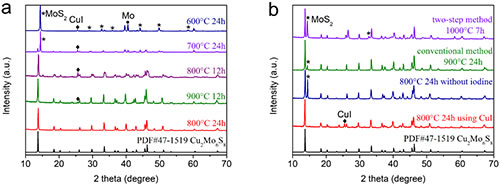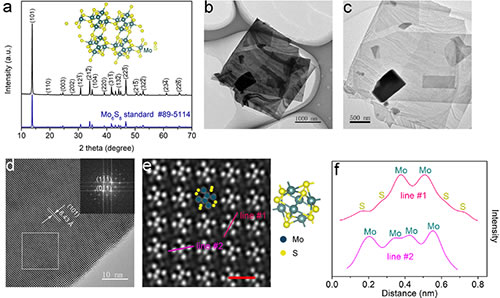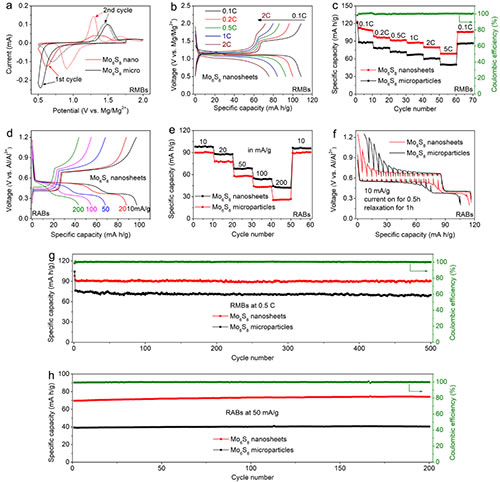The Chevrel phase compound is a molybdenum-based chalcogenide compound composed of Mo6T8 or MxMo6T8 (M is a transition metal and T is S, Se or Te). In the Chevrel phase structure, six Mo atoms are located at the six face centers of a cube, forming an octahedral Mo6 atomic cluster, and eight T atoms occupy the eight corners of the cube. Large three-dimensional open channel. Because of this unique structure, Chevrel phase compounds are used in superconductivity, thermoelectricity, catalysis, and batteries. Since the Chevrel phase Mo6S8 was first applied to the positive electrode of magnesium batteries in 2000, its application range has been broadened to almost all secondary battery systems. To this day, Chevrel Mo6S8 is still the most successful cathode material for magnesium batteries. But large-scale, high-quality synthesis of Chevrel phase Mo6S8 nanomaterials still faces great challenges. Current methods include solid-phase method, molten salt method, self-transporting high-temperature method, high-energy ball milling method, and two-step solution method synthesis, which have problems of large energy consumption, impure products, and inability to control particle growth. At present, the most commonly used solid-phase method uses CuS and MoS2 as sulfur sources to seal the reactants into a joint stainless steel tube filled with argon and react at 900 degrees Celsius for 24 hours. However, this method can only synthesize Mo6S8 with micron size, and because CuS will decompose at high temperature to generate sulfur vapor and escape, resulting in the formation of impurity MoS2.
In view of this, Mao Minglei, Ph.D. student and Lin Zejing, group E01, Clean Energy Laboratory, Institute of Physics, Chinese Academy of Sciences / National Research Center for Condensed Matter Physics, Beijing, and under the guidance of Associate Researcher Suo Minmin, synthesized large-scale gas-phase mass transfer reactions using , High purity Mo6S8 nanosheets. Using Cu, Mo, and MoS2 as reactants, the decomposition of the reactants and the escape of sulfur vapor are avoided. Iodine is used to adjust the kinetics of the solid-phase reaction, which reduces the reaction temperature and time, and initiates preferential planar growth of Mo6S8 to form nanosheets. As a typical three-dimensional material, nanosheet Mo6S8 was obtained for the first time. In magnesium batteries and aluminum batteries, the Mo6S8 nanosheets have faster ion insertion kinetics and better electrochemical performance than microparticles synthesized by traditional methods. The results of this study were published recently on ACS Nano (ACS Nano, 2019, DOI: 10.1021 / acsnano.9b08848). The article is titled Iodine Vapor Transport-Triggered Preferential Growth of Chevrel Mo6S8 Nanosheets for Advanced Multivalent Batteries.
The research team first explored the optimal synthesis conditions. By XRD testing the products at different reaction temperatures and reaction times, it was found that 800 degrees Celsius and 24 hours were the best synthesis conditions. At the same time, further research on the reaction path revealed that iodine vapor first reacted with copper to form CuI, and then reacted with Mo elemental and MoS2 to generate intermediate product Cu2Mo6S8. The intermediate product was further pickled to produce the target product Mo6S8 nanosheets. Then the author used XRD, SEM, TEM, STEM and other means to confirm the crystal phase and morphology of the synthesized Mo6S8 nanosheets. Subsequently, Mo6S8 nanosheets were applied to magnesium batteries and aluminum batteries. Mo6S8 nanosheets exhibited faster reaction kinetics, excellent cycle stability, and good low-temperature performance. In addition, the research team also used ex-situ XRD, EDS, and XPS to prove that Mo6S8 nanosheets undergo a significant phase change during the insertion and extraction of magnesium ions, and the charge transfer begins with sulfur ions and then transitions To molybdenum ions. In addition to being applicable to battery materials, Mo6S8 nanosheets can be widely used in superconductivity, thermoelectricity, and catalysis due to their high specific surface area, significant anisotropy, and unique surface properties. The gas-phase mass transfer reaction of iodine will provide a completely new route for large-scale synthesis of inorganic compounds.
Related work has been supported by the National Key Research and Development Program (2018YFB0104400), the National Natural Science Foundation of China (51872322; 21905299), the China Postdoctoral Science Foundation (2019TQ0346), and Shell (PT76419).

Figure 1. Schematic diagram of the synthesis of Mo6S8 nanosheets by vapor-phase mass transfer reaction of iodine.

Figure 2. Using XRD to explore the optimal conditions and reaction path for the synthesis of Cu2Mo6S8.

Figure 3. Characterization of Mo6S8 nanosheets

Figure 4. Electrochemical performance of Mo6S8 nanosheets in magnesium batteries and aluminum batteries
Pe Plastic Sheet, full name is Polyethylene Sheet.
Physical properties: PE plastic Sheet is the most simple structure of the macromolecular organic compounds, the world's most widely used polymer materials, composed of ethylene polymerization, depending on the density is divided into high density polyethylene, medium density polyethylene and low density polyethylene.
(1) LDPE Sheet
Low density polyethylene Sheet (also known as high pressure polyethylene Sheet)
(2) LLDPE Sheet
Linear low density polyethylene
(3) MDPE Sheet
Medium density polyethylene
(4) HDPE Sheet
High density polyethylene (also known as low pressure polyethylene)
(5) UHMWPE Sheet
Ultra high molecular weight polyethylene(6)Modified polyethylene sheet
Chlorinated polyethylene (CPE) and crosslinked polyethylene (PEX)
(7)Ethylene - ethylene copolymer
Ethylene/propylene copolymer (plastic), EVA, ethylene, ethylene butene copolymer - other olefins, such as octene POE, cyclic olefin copolymer, ethylene/unsaturated ester copolymer (EAA, EMAA, EEA, EMA, EMMA, EMAH).
Polyethylene, which has a molecular weight of 3 million to 6 million, is known as UHMWPE.
Ultra high molecular weight polyethylene is very strong and can be used for body armor.
1. Papermaking industry: suction box board, scraper, molding plate, bearing, gear;
2. Mining industry: charging barrel, abrasive and adhesive-resistant back lining for warehouses;
3. Chemical industry: acid pump, filter plate, worm gear, bearing;
4. Food industry: packing machinery parts, bottle guide, screw, wear plate, slide way, stud weld, roller and other transmission parts;
5. Textile industry:buffer board;
6. Food processing industry: chopping block, refrigerating plant;
7. Wharf: anti-collision board.
1. Acid and alkali resistance, resistance to organic solvents
2. Excellent electrical insulation and static resistance
3, Can still maintain a certain touness even at low temperature
4. Extremely high impact strength
5. Low friction coefficient
6. Non-toxic
7. Low water absorption
8.Lower density than any other thermoplastic plastics (<1g/cm3)
Disadvantages:
PE Plastic sheet have Weak mechanical property, air permeability, easy deformation, easy ageing, brittle, brittle less than PP, easy stress cracking, surface hardness, easy to scratch.
Difficult to print, in printing, surface discharge treatment, cannot electroplating, the surface has no luster.
Specification: the diameter of the PE rod can be produced from 2mm to 250mm. The conventional length is 1000mm, and the length is unlimited.
The thickness of PE sheet material can be produced from 0.3mm to 1.9mm, the normal width is 600mm, the width cannot exceed 1200mm, the length is not limited.
The thickness of plate can be produced from 2mm to 180mm, the usual specification of 2-10mm is 1000mm* 2000mm, and the commonly used specification of10-180mm is 600*1200mm.PE sheet can also be customized according to requirements, and the width cannot exceed 1200mm, and the length is not limited
Color: natural color is wax white, also can be customized black and color, the order of the color to order is 500KG.
Add antistatic agent to the permanent antistatic electric bar, and the volume resistance value is between 6 to 9 power of 10.Add flame retardant to the flame retardant rod from UL 94V-0 to HB flame retardant grade, and other modification requirements are required to customize various additional properties according to the actual use of the customer.
Combustion characteristics:
Combustion situation: easyCombustion flame status: molten drop, yellow lower blue
After the fire: continue to bur
Smell: the smell of wax burning
Product certification: most environmental certification reports and safety reports for raw materials, such as SGS report, CTI report, UL report, MSDS safety information, etc.
Pe Plastic Sheet,White Pe Plate,Standard Material Pe Plastic,Transparent Pe Plastic Sheet
Dongguan Noegem Plastic Products Co.,Ltd , https://www.noegempLastic.com